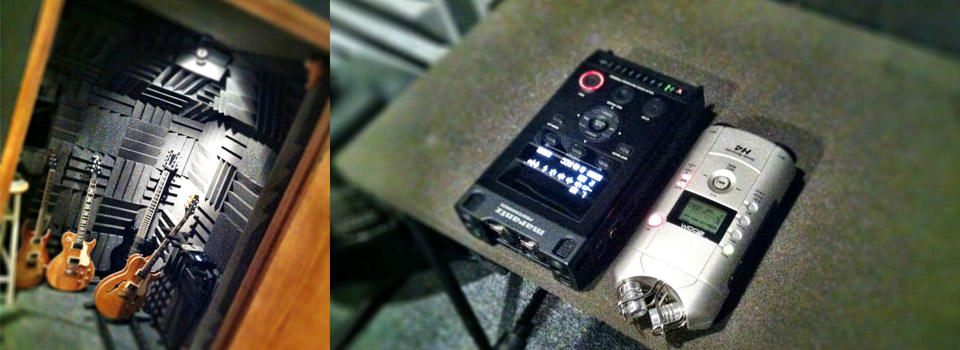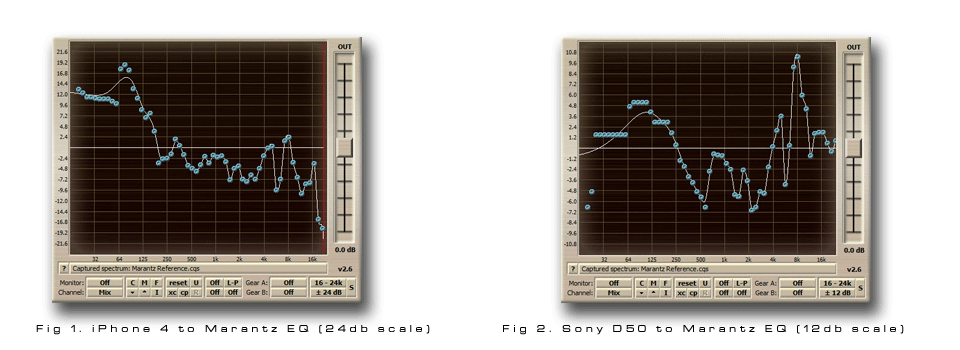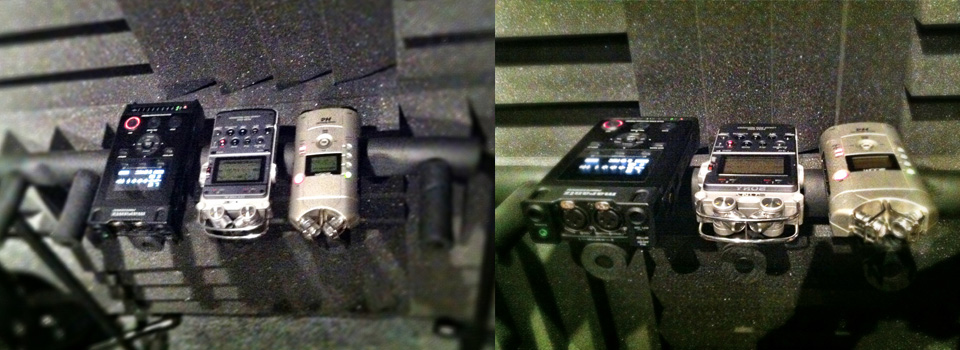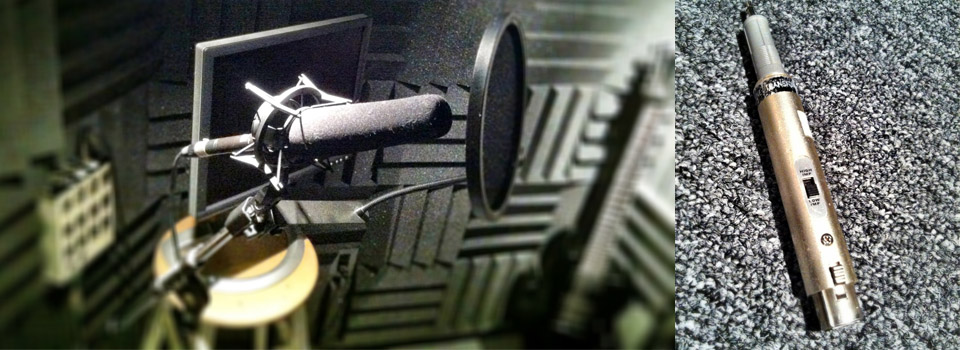Portable Recorders 1 Mic Tests: Zoom H4, Marantz PMD 661,Sony PCM D-50, iPhone 4
There are a myriad of uses for portable recorders and I like to use them for SFX recordings. I tend to prefer recording SFX with a shotgun microphone because it focuses the sound and removes a lot of the extraneous ambient noise. Even though a good deal of noise can be removed in post, I find that hiss and high frequency noise is difficult to remove without degrading the audio noticeably. Once cleaned and eq’d, I find those samples don’t sit well in a mix, especially if they are looping sounds, and they tend to add a white noise quality to the game overall. On occasion, the less desirable internal mics are needed for stereo recordings or for quick captures.
Test 1: Marantz PMD661 vs. Zoom H4
Using the internal mics I recorded a VO in a rather quiet Iso Booth at 96KHz 24bit. I placed the recorders side by side about 2″ apart resting on a non reflective and acoustically transparent foam surface 3 ft from the ground and 10″ from a padded non reflective wall. Even though recorders are capturing an identical take, and my mouth is 12 inches from their center point, it’s not a perfectly identical recording for both machines. But it’s probably close enough.

Files below are 16bit mp3 VBR @48KHz. To do accurate A/B tests compare files only within each test as they have been normalized accurately. The frequency curve of the Zoom was matched to the Marantz using Voxengo and the files were normalized to be identical volume.
Zoom
Marantz
Test 2: Marantz PMD661 vs. Sony PCM D-50 vs. iPhone 4
Why not use the iPhone 4 as a yardstick? I’ve done quick recordings for video using the iPhone in a shirt pocket before, and in a pinch, it’s way better than the video camera mic. I used the Marantz recording as the reference and frequency matched the Sony and iPhone4 to match. Tascam PCM Recorder app (which allows for uncompressed wav file on the iPhone) was used but the iPhone file 44.1KHz 16bit as compared to the 96KHz 24bit files in the other recorders. Still, I think it’s a valid and useful comparison.

The iPhone has no bottom end so checkout how hard the EQ curve had to work (left graph at 25db scale) to match it on the graphs above. The Sony EQ matching (right graph 12db scale) is not as extreme. It’s amazing how well matched the results are.
Marantz
Sony
iPhone 4
Test 3: Marantz PMD661 vs. Sony PCM D-50 vs. Zoom H4
Oops forgot to included the Zoom in test 2. Here we go !

Marantz
Sony
Zoom
Test 4: Shotgun Mic into: Marantz PMD661, Sony PCM D-50, Zoom H4
A couple of things to note. Microphone used was the Sennheiser K3/ME80. Both the Marantz and Zoom have XLR inputs with 48V phantom available, whereas the Sony has only an unbalanced 3.5mm stereo jack input. I used an inexpensive inpedence matching transformer set to record the ME80 which was powered by the internal battery. As you listen to these 3 files, keep in mind these are 3 different takes so there will be some discrepancies in the vocal delivery.

Marantz
Sony
Zoom
Conclusions:
Matching frequencies removed the most audible difference and subjective EQ while letting us focus on the noise. Since what I record gets heavily eq’d and processed, I’m not that concerned with the mic frequency response that much, unless the EQ adds a significant amount of noise back in the recording.
Marantz PMD 661: has the best input pre-amps in terms of frequency response and noise. Unfortunately it also has the most hiss on the internal microphones rendering the on-board mics unusable. Very dissapointing.
Sony PCM D-50: has the least noise when using the internal mics, the preamp when used in conjunction with an Impendence matching transformer is almost as clean as the Marantz, but not quite. I can hear about 1-2db more noise (either because of my Transformer or due to the unbalanced input… who knows?)
Zoom H4: mics and XLR inputs have more noise than the Sony, it’s noticeable to the point I wouldn’t bother using it moving forward.
iPhone 4: has more noise than all of the above EXCEPT the Marantz. The Marantz seems to have massive broadband hiss whereas the iPhone has a noise spectrum that is in very high frequencies. I find the iPhone noise less objectionable.
My Marantz (sadly) is going back to the store (I’ve got an RMA number already) and the only question remains, is the newer Zoom H4n as good as the Sony ? I know the recording circuitry introduces harmonic distortion for the H4n, but having XLR inputs and 48V might be worthwhile, assuming the noise floor is decent. The search continues…
Download source files:
Check out the original uncompressed unaltered 96KHz, 24bit recordings, normalized-only versions, normalized and frequency matched, screenshots of the curve matching eq, and other tidbits.

